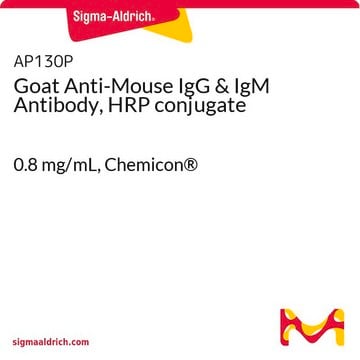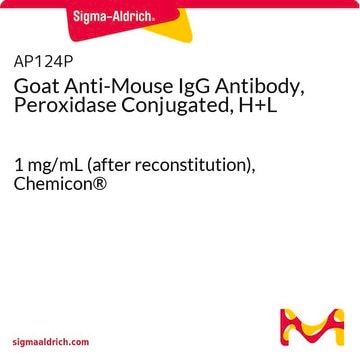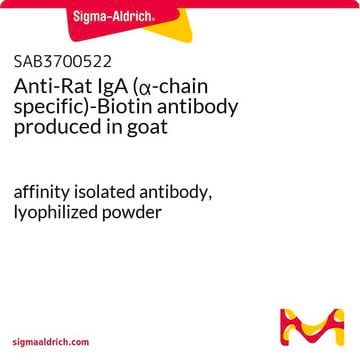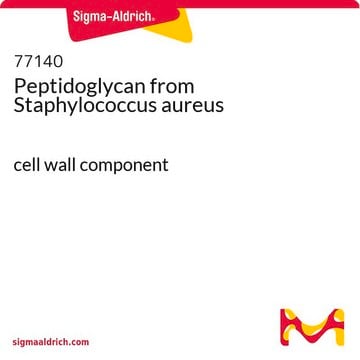MAB995
Anti-Bacterial Peptidoglycan Antibody, clone 3F6B3
ascites fluid, clone 3F6B3, Chemicon®
Synonym(s):
PG
Sign Into View Organizational & Contract Pricing
All Photos(1)
About This Item
UNSPSC Code:
12352203
eCl@ss:
32160702
NACRES:
NA.41
Recommended Products
biological source
mouse
Quality Level
antibody form
ascites fluid
antibody product type
primary antibodies
clone
3F6B3, monoclonal
species reactivity
bacteria
manufacturer/tradename
Chemicon®
technique(s)
ELISA: suitable
dot blot: suitable
immunocytochemistry: suitable
isotype
IgG1
shipped in
wet ice
Specificity
Specific for the three-dimensional polymer complex structure of PG. The epitopes appear to consist of discontinuous glycan and/or amino acid residues, and have not been fully defined. In a competitive immunoassay format, several compounds were found to be ineffective as inhibitors: muramyldipeptide, N-acetylglucosamine (NAG), chitin (polymer of NAG) and acid-hydrolyzed chitin (NAG oligomers).
Immunogen
Insoluble PG obtained by TCA-heat and ethanol extraction of Streptococcus mutans BHT cells.
Application
May be used in solid-phase or competitive ELISA, immunodot-blot and immunocytochemistry formats. Although PG is a bacterial surface component, pre-treatments, such as treatment with strong acid (25mM HCl), for Gram-positive bacteria, or with a detergent, such as SDS or Triton-X (1% in PBS), for Gram-negative bacteria, may be necessary to expose the epitopes.
Optimal working dilutions must be determined by end user.
Optimal working dilutions must be determined by end user.
Research Category
Infectious Diseases
Infectious Diseases
Research Sub Category
Infectious Diseases - Viral
Infectious Diseases - Viral
This Anti-Bacterial Peptidoglycan Antibody, clone 3F6B3 is validated for use in DB, ELISA, IC for the detection of Bacterial Peptidoglycan.
Physical form
Ascites fluid, no preservatives. Liquid.
Storage and Stability
Maintain at -20°C in undiluted aliquots for up to 12 months. Avoid repeated freeze/thaw cycles.
Legal Information
CHEMICON is a registered trademark of Merck KGaA, Darmstadt, Germany
Disclaimer
Unless otherwise stated in our catalog or other company documentation accompanying the product(s), our products are intended for research use only and are not to be used for any other purpose, which includes but is not limited to, unauthorized commercial uses, in vitro diagnostic uses, ex vivo or in vivo therapeutic uses or any type of consumption or application to humans or animals.
Not finding the right product?
Try our Product Selector Tool.
Storage Class
10 - Combustible liquids
wgk_germany
WGK 1
flash_point_f
Not applicable
flash_point_c
Not applicable
Certificates of Analysis (COA)
Search for Certificates of Analysis (COA) by entering the products Lot/Batch Number. Lot and Batch Numbers can be found on a product’s label following the words ‘Lot’ or ‘Batch’.
Already Own This Product?
Find documentation for the products that you have recently purchased in the Document Library.
Judith Miklossy
Journal of Alzheimer's disease : JAD, 53(4), 1459-1473 (2016-06-18)
It has long been known that spirochetes form clumps or micro colonies in vitro and in vivo. Cortical spirochetal colonies in syphilitic dementia were considered as reproductive centers for spirochetes. Historic and recent data demonstrate that senile plaques in Alzheimer's
T Wagner et al.
Journal of proteomics, 187, 28-38 (2018-06-02)
Enterococcus faecium is a commensal but also a bacteremia causing pathogen, which is inherently resistant to several antimicrobials and has a great ability to acquire new traits. Bacterial membrane vesicles (MVs) are increasingly recognized as a mode of cell-free communication
Brain microbial populations in HIV/AIDS: ?-proteobacteria predominate independent of host immune status.
Branton, WG; Ellestad, KK; Maingat, F; Wheatley, BM; Rud, E; Warren, RL; Holt et al.
Testing null
Emily Eckman et al.
Journal of molecular medicine (Berlin, Germany) (2021-06-09)
A panel of 10 IgG enzyme-linked immunosorbent assays (ELISAs) were developed for the detection of anti-microbial immune responses in the cerebrospinal fluid (CSF) of patients with demyelinating diseases (DD). The anti-microbial ELISA assays follow on prior human brain tissue RNA
W G Branton et al.
Scientific reports, 6, 37344-37344 (2016-11-29)
Microbial communities reside in healthy tissues but are often disrupted during disease. Bacterial genomes and proteins are detected in brains from humans, nonhuman primates, rodents and other species in the absence of neurological disease. We investigated the composition and abundance
Our team of scientists has experience in all areas of research including Life Science, Material Science, Chemical Synthesis, Chromatography, Analytical and many others.
Contact Technical Service








